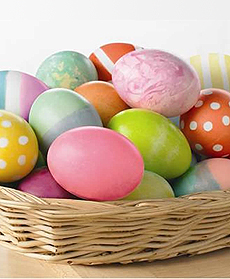

A basket of beautiful eggs to serve on Easter. Photo courtesy McCormick.
March 2010
|
 |
Easter Brunch
Festive Recipes To Share With Friends & Family
Page 1: Homemade Decorated Easter Egg Basket
Whether or not you’ve outgrown the Easter egg hunt, you’re never too old for Easter brunch. Invite friends or family members, and share a special egg-filled celebration with them. Here, we present four recipes perfect for holiday brunch, plus instructions on how to make perfect decorated Easter eggs, courtesy of spice company McCormick.
This is Page 1 of a five-page article. Click on the black links below to visit other pages. Also see our glossary of Types Of Eggs.
Decorated Easter Eggs
It just wouldn’t be Easter without colorfully dyed, hard-cooked eggs. Plus, hard-cooked eggs are a tasty source of protein; if you still have some left over after your brunch party, you can turn them into egg salad, deviled eggs or a low-calorie snack. Hard-cooked eggs in the shell can keep for one week; peeled eggs should be eaten within a day.
Note that in this recipe, what many people refer to as hard-boiled eggs are actually hard-cooked eggs. That’s because the eggs are not boiled. While the cooking water comes to a full boil, the pan is immediately removed from the heat so that the eggs cook gently in the hot water off the flame. Hard-cooking, as opposed to boiling over the flame, produces tender eggs and minimizes cracking.
Ingredients
- 1 dozen large eggs
- Food coloring (McCormick makes a collection of regular colors plus neon colors for extra bright eggs)
- Vinegar
Preparation
- Gently place eggs in single layer in large saucepan. Add enough cold water to cover
eggs by 1 inch. Cover. Bring just to boil on high heat. Remove from heat. Let stand 15
minutes. (Adjust time up or down by 3 minutes for each size larger or smaller.)
- Pour off hot water and rapidly cool eggs by running them under cold water (or place in
ice water) until completely cooled.
- For one-color eggs, mix 1/2 cup boiling water, 1 teaspoon vinegar and food color, one drop at a time until you reach desired shade. A small coffee cup works best because the entire egg will be submerged in the dye. Repeat for each color. Dip hard-cooked eggs in dye for about 5 minutes. Using a slotted spoon, wire egg holder or tongs, remove eggs from dye. Transfer back to egg carton to allow eggs to dry.
- For two-tone eggs, prepare as many colored dyes as desired in cups. Use a shallow bowl
for this so that the depth of the dye only reaches halfway on the egg. Holding egg
lengthwise, dip it into the dye for 5 minutes. You need to hold the egg up so that
only the bottom half remains in the dye. Remove egg from dye and dry on paper towels.
Dip undyed half of egg in second color, repeating the process so that only the undyed
half is in the dye. As a variation, you can also leave a band of undyed white around the
middle of the egg.
- For personalized eggs, write initials, names or draw pictures on the egg with a white or light colored crayon
before dyeing. The wax from the crayon will keep the shell underneath it from taking dye.
- For tie-dye eggs, place several eggs in a colander in the kitchen sink. Splash eggs with vinegar. Drop
yellow food color onto eggs. Gently shake the colander for a few seconds to help the
color spread. Let stand 30 seconds. Repeat with 1 or 2 additional food colors. After the
final stand time, lightly rinse eggs with water. Drain completely. Allow eggs to dry.
- For marbleized eggs, mix 1/4 cup boiling water, 1 teaspoon vinegar, 1/8 teaspoon oil and 4 to 8 drops food color in shallow bowl. Make sure to agitate dye with a fork or small whisk so oil droplets are small. Gently roll egg in the mixture for 30 seconds, or until the egg is the desired shade. Transfer the egg to a second color mixture, and repeat the process. Allow the egg to dry completely. Wipe away excess oil with a paper towel.
- Refrigerate eggs until ready to serve. Present in a basket or set an egg at each place—in an egg cup, a nest of Easter grass or other presentation of your choice.
- Consume uneaten eggs in the shell within a week. Peeled eggs should be consumed within a day—with seasoning (salt, pepper, herbs); in a sliced egg sandwich or egg salad; or halved/quartered/sliced as a plate garnish with other foods.
Continue To Page 2: Cheesy Bacon & Egg Casserole
Go To The Article Index Above
Recipe courtesy McCormick. All other materials

|




